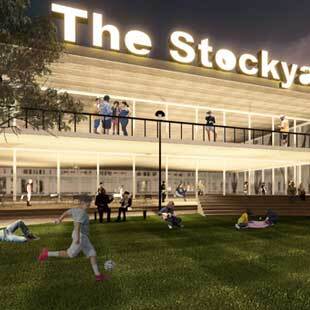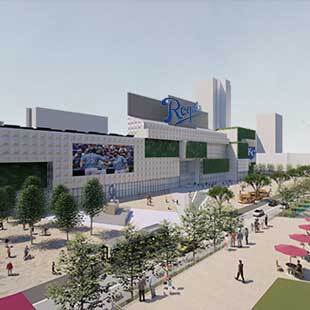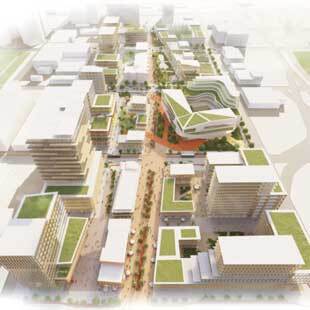Four teams have been selected as the finalists for the 19th annual ULI Hines Student Competition, an event that challenges graduate students to devise a comprehensive design and development plan for a real site in an urban area. Finalists include a team from the Georgia Institute of Technology and one from the University of California, Berkeley. Finalists also include a combined team from Pennsylvania State University, the University of Houston, and Columbia University in the City of New York, in addition to a Toronto-based team from Ryerson University, York University, and the University of Toronto.
This year’s competition asked students for proposals to create a thriving mixed-use, mixed-income area in the East Village neighborhood of downtown Kansas City, Missouri. The challenge brief asked the students to address housing affordability, equity, transportation, mobility, sustainability, and resilience in their proposals. The competition, which began January 11, simulates an actual design, planning, and development scenario, and reflects Kansas City’s vision to ensure that its greater downtown is a vibrant, connected core for the city and region. The four teams now advance to the final round of the competition in April, where they will compete for a $50,000 prize.
The finalists are:
- Cattlyst from the Georgia Institute of Technology (contestants Erin Heidelberger, Akhilesh Dhurkunde, Huangzhe Zhao, Robin Cornel, and Alex Sovchen). Cattlyst celebrates Kansas City’s agricultural roots while launching the city into the future of food. The development serves as a complete community focused on showcasing innovation in food technology. It leverages partnerships with existing companies, startups, and universities, as well as its location in the central business district, to capitalize on the growing biotech workforce by establishing itself as an innovation corridor anchored by a diverse neighborhood.More on Cattlyst.
- EAVIRO District Development Plan from the University of Houston, Pennsylvania State University, and Columbia University in the City of New York (contestants Jie Yang, Hillary Telegrafo, and Jose Medina from the University of Houston; Yiru Zhang from Pennsylvania State University; and Wenjuan Li from Columbia University). EAVIRO is a mixed-use, mixed-income neighborhood that sets out to redefine the built environment and quality of life within the city through economic development, sustainable and resilient design initiatives, and creating inclusive communities. The project presents a state-of-the-art Kansas City baseball stadium that is envisioned as a new economic driver that will have a catalytic and valuable impact on the future of Kansas City.More on EAVIRO District
- Fusion from Ryerson University, York University, and the University of Toronto (contestants Frances Grout-Brown and Leorah Klein, Ryerson University; Yanlin Zhou, York University; Ruotian Tan and Chenyi Xu, the University of Toronto). Seamlessly fusing the East Village, Paseo West, and Kansas City’s downtown core, Fusion is a welcoming and affordable mixed-use development, where everyone who wishes to call it home, can. Designed around two key pillars—connectivity and resilience—this Leadership in Energy and Environmental Design (LEED) neighborhood embodies inclusive and sustainable growth within Kansas City. More on Fusion.
- Homebase from the University of California, Berkeley (contestants Alice An, Romi Bhatia, Elliot Kwon, Tara Singh, and Wayne Kim). Homebase is a transformational $1.4 billion mixed-use, mixed-income development anchored by Stadium 42. The relocation of the KC Royals baseball stadium to the urban core will catalyze a much-needed connection between Paseo West and the East Village. Through job creation, affordable living, and a forward-thinking urban transportation system, Homebase will revitalize this downtown neighborhood and become the heartbeat of Kansas City. More on Homebase.
The finalists were chosen from 105 entries by a jury of 16 leading ULI members representing a broad variety of real estate and related disciplines. This year, students formed teams representing 61 different universities in the United States, Canada, and Singapore, including 31 teams with students from more than one university.
ULI Trustee Diana Reid of Pittsburgh, who was the chair of the 2021 ULI Hines jury, remarked on the participants’ ability to rise to the challenge of remote collaboration.
“Even though teams weren’t able to meet in person, they produced proposals that were every bit as sophisticated as in prior years,” she said. “It was inspiring for the jurors to see the next generation of the real estate industry. Ultimately, the final four teams had a strong vision aligned with the challenge, balanced urban design with financial feasibility, demonstrated teamwork, and showed potential to improve on their original proposals in the finals.”
Nine entries received honorable-mention recognition: East Village Link from the University of Calgary; reRoot from the Ohio State University; the Bowline from Columbia University in the City of New York; the Combine from the University of Cincinnati; the Junction from Cornell University; the KC Knot from Carnegie Mellon University; the Prairie from the University of Miami and the University of California, Berkeley; the Spine from the University of Waterloo and the University of Toronto; and the Weave from the University of California, Berkeley.
During the last phase of the competition, the finalist teams will have the opportunity to expand their original projects and provide more detail for their plans. The finalists will meet with local stakeholders on March 5 to learn even more about the site and city, and present to a rehearsal jury on March 19. At the finals on April 8, each team will deliver its presentations in front of the same jury of ULI members that selected the finalists, and the jury will select the winning team that day. The winning team will receive a $50,000 prize, with $5,000 of the total going to the university or universities the team represents. Each of the remaining three finalist teams will receive $10,000.
The competition jury consists of renowned experts from diverse backgrounds in commercial real estate, land use, and design. In addition to the jury chair, Diana Reid, members of the jury are: Randy Bredar, senior vice president, JE Dunn Construction, Kansas City, Missouri; Lynn Carlton, vice president, regional planning, HOK, Kansas City, Missouri; Fernando Costa, assistant city manager, city of Fort Worth, Texas; John Gilmore, managing director, Walker & Dunlop, New York City; Kona Gray, principal, EDSA, Fort Lauderdale, Florida; Veronica Hackett, principal, the Clarett Group, New York City; Faron A. Hill, founder and president, Peregrine Oak, Atlanta; Steve Kenat, principal, GBBN, Cincinnati, Ohio; Jill McCarthy, senior vice president, Kansas City Area Development Council, Kansas City, Missouri; Susan Meaney, senior adviser, KSL Capital Partners, San Francisco; Joe Perry, vice president, Port KC, Kansas City, Missouri; Geeti Silwal, principal, Perkins+Will, San Francisco; Amy Slattery, founder and chief executive officer, Odimo, Kansas City, Missouri; Lauren Standish, vice president, HGOR, Atlanta; Margaret Wylde, chief executive officer, ProMatura Group LLC, Oxford, Mississippi.
The ULI Hines Student Competition was created with a generous endowment from longtime ULI leader Gerald Hines, the late founder of the Hines real estate organization. The program is part of an ongoing ULI effort to raise interest among young people in creating better communities and improving urban development patterns. The competition encourages cooperation and teamwork—necessary talents in the planning, design, and development of sustainable communities—among future land use professionals and allied professions. More information about the 2021 competition is available online.








